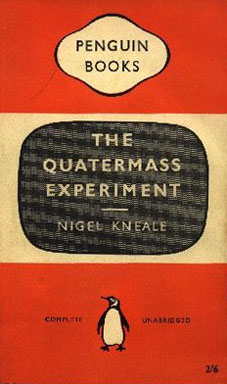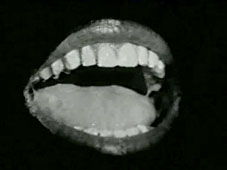
Nigel Kneale, creator of the Quatermass series, The Stone Tape and Beasts, died this week.
A journal by artist and designer John Coulthart.
Film

Nigel Kneale, creator of the Quatermass series, The Stone Tape and Beasts, died this week.
More happy news from the Great Banana Republic Across the Water: the Dixie Chicks, who faced earlier censure and death threats for daring to criticise Generalissimo President Bush and the war in Iraq, have had their ad for movie Shut Up and Sing stopped by NBC who say they “cannot accept these spots as they are disparaging to President Bush.” Cowards. Think Progress has the offending item so you can judge for yourself.
In my obsession with all things Orson Welles, his 1936 production of Macbeth holds a special fascination, partly for being my favourite Shakespeare play, and partly for the curiosity of its production—an all-black cast that included genuine Haitian drummers who famously claimed to have drummed a Broadway critic to death after he gave the play a hostile review. The De La Warr Pavilion in Bexhill-on-Sea is hosting an art event based on Welles’ production.
In 1936, whilst the UK was celebrating the new De La Warr Pavilion, and exciting artistic movement was reaching its close in New York—the Harlem Renaissance. A significant event within of this movement was an all-black African American version of Macbeth, presented by The Federal Theatre Project at the New Lafayette Theatre, Harlem and directed by writer and actor Orson Welles. This production became known as ‘Voodoo Macbeth‘.
There are many things that were remarkable about this unique and innovative project. The play was one of the first explorations of a modern and diasporic spin on the Shakespearian tale. It was also the point at which Welles was introduced to John Houseman, which then led to the formation of the Mercury Theatre Company that produced seminal works such as the War of the Worlds and Citizen Kane. Furthermore, the ‘Voodoo Macbeth‘ production displayed visual and aural motifs using lighting, stage design and overlapping sound which became signature elements to Welles’s later film projects.
The essence, spirit, and cross-artform experimentality of ‘Voodoo Macbeth‘ is the basis for a contemporary art, film and performance season at the De La Warr Pavilion and has been named after the production. This unique project looks at the historical and contemporary dialogue that Welles’s work had and still has with performance, film and visual art.
The curatorial concept of the De La Warr Pavilion’s exhibition Voodoo Macbeth focuses on the debate and the ideas around Welles’s unique and defining aesthetic which continues to attract much critical attention. The exhibition suggests that Welles’s approach has informed the work of many contemporary artists working in film today.
Both the historical and contemporary context of Voodoo Macbeth are explored within the exhibition and wider season of events. Original works by Orson Welles are presented alongside those of his contemporaries including Jean Cocteau, Jacques Tourneur and Lee Miller. These artists were working with film and photography during the period of the 1940s onwards and have a shared concern in exploring visual ideas and motifs around the idea of an ‘expansive frame’. As artists, they blurred the boundaries between visual art, theatre, literature and film, to produce lyrical and poetic visual works.
Work by contemporary artists within the exhibition have been selected on the basis that their work embodies the artistic narrative and the spirituality of Welles’s use of light, dark and spatial composition. The exhibition includes work by Phyllis Baldino, Glenn Ligon, Steve McQueen, Mitra Tabrizian and Kara Walker. In this context, Voodoo Macbeth explores how, for artists today, the genre and its relationship to installation practice in performance, film, sound and visual art is an important part of the process. Importantly, they do not mimic the formalist structure of film, painting and sound but endeavour to embed these works with elements of popular culture, critique and humour. Like Welles, who was a masterful story teller, these artists have developed works which take on the character of an intimate 21st century tale. Unlike Welles, these tales are tailor-made, for a gallery audience to explore and enjoy.
Produced by the De La Warr Pavilion in association with Brighton Photo Biennial and curated by associate curator David A Bailey in collaboration with BPB curator 2006 Gilane Tawadros.
The Galleries are open 10am–6pm except on Christmas Eve (closing
at 5pm), Christmas Day (closed all day) and New Year’s Eve (closing at 3pm). Free.Voodoo Macbeth, Oct 7th–Jan 7th.
The Voodoo Macbeth exhibition is a part of the Brighton Photo Biennial, for more details on the BPB please visit their website www.bpb.org.uk, or contact them via the details below.
Biennial Office
University of Brighton
Grand Parade
Brighton BN2 0JYTel: +44 (01)273 643 052
Email: mail@bpb.org.uk
 ‘He created his own universe and became its star’
‘He created his own universe and became its star’
Director David Cronenberg explains the debt he owes to Andy Warhol’s bizarre and chillingly prophetic work
David Cronenberg
Monday September 11, 2006
The Guardian
EMPIRE IS THE CLASSIC. It was outrageous—yet somehow it worked. An eight-hour shot of the Empire State Building, it was high concept, not in the Hollywood sense, but the art sense. It’s got potency, resonance. Andy even said the Empire State Building was a star. It’s so New York, which was the centre of the artistic universe at the time, the 1960s. That’s why I decided to begin the Andy Warhol show I am curating with Empire.
I can’t recall when I first saw a Warhol. I feel as though he was always in my consciousness. I started making films at the same time he did, and the New York underground scene is what influenced me—and that was Andy. He didn’t think you needed access to anything to do what he was doing—just grab a camera, do your own thing, and it’ll work.
Preparing this exhibition, I was initially planning to ignore the films. It seemed too obvious to bring a film-maker in and for him to choose the films. But I didn’t have to dig deep to realise it would be a major oversight. Andy started the silk screens, the film-making and the Death and Disaster series at the same time. Everything influenced everything.
 A TV screening in 1970s of this mouth muttering in darkness was my first introduction to Beckett‘s work and a very memorable and disturbing introduction it was. It made no sense at the time since I had no cultural context in which to place it, it felt like being plugged directly into some kind of fever dream. The brilliance of Beckett’s work is reinforced by the way the repetitions and evasions of this piece often came to mind during fevers of my own, those moments when you’re ill and trying to sleep and the brain is caught in a recursive loop from which there seems to be no escape. Beckett at his best succeeds in fixing these twilight states in a way that few other writers achieve so it’s good to be able to see this again. The version at Ubuweb is the BBC rescreening from 1990 that included an introduction by Billie Whitelaw.
A TV screening in 1970s of this mouth muttering in darkness was my first introduction to Beckett‘s work and a very memorable and disturbing introduction it was. It made no sense at the time since I had no cultural context in which to place it, it felt like being plugged directly into some kind of fever dream. The brilliance of Beckett’s work is reinforced by the way the repetitions and evasions of this piece often came to mind during fevers of my own, those moments when you’re ill and trying to sleep and the brain is caught in a recursive loop from which there seems to be no escape. Beckett at his best succeeds in fixing these twilight states in a way that few other writers achieve so it’s good to be able to see this again. The version at Ubuweb is the BBC rescreening from 1990 that included an introduction by Billie Whitelaw.
Not I (1973)
149.6 mb (avi), 15’06”
Starring and Introduced by Billie Whitelaw
Not I takes place in a pitch black space illuminated only by a single beam of light. This light illuminates an actress’s mouth. The mouth utters a monologue of fragmented, jumbled sentences which gradually coelesces into a narrative about a woman who has suffered an unpleasant experience. The title comes from the character’s repeated insistence that the events she describes did not happen to her.
The stage directions also call for a character called ‘the Auditor’ who wears a black robe and can be dimly seen at the back of the stage, occasionally raising its hands in a gesture of impatience. When Beckett came to be involved in staging the play, he found that he was unable to place the Auditor in a stage position that pleased him, and consequently allowed the character to be omitted from those productions. However, he did not decide to cut the character from the published script, and whether or not the character is used in production seems to be at the discretion of individual producers. As he wrote to two American directors in 1986: “He is very difficult to stage (light–position) and may well be of more harm than good. For me the play needs him but I can do without him. I have never seen him function effectively.”
Previously on { feuilleton }
• Film by Samuel Beckett